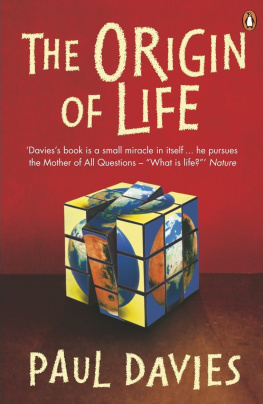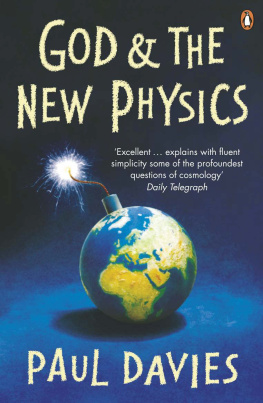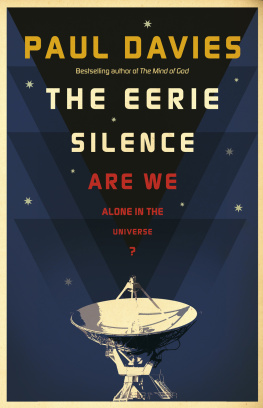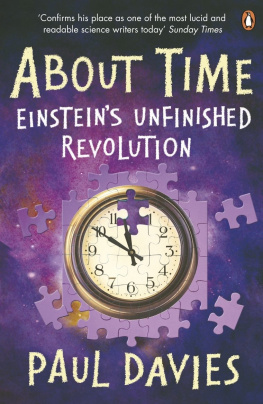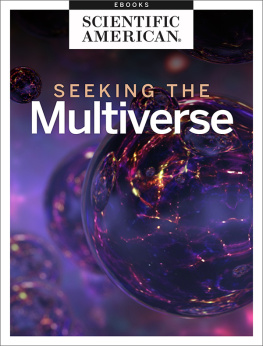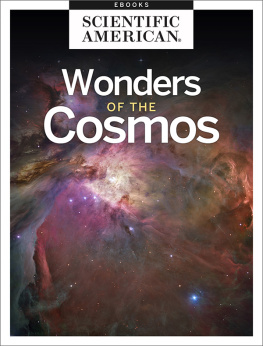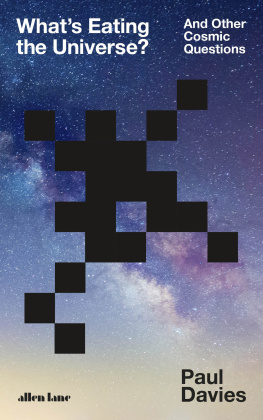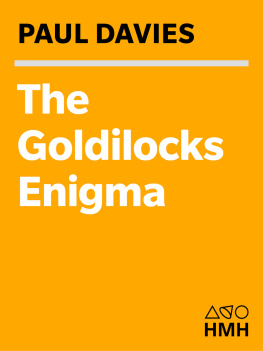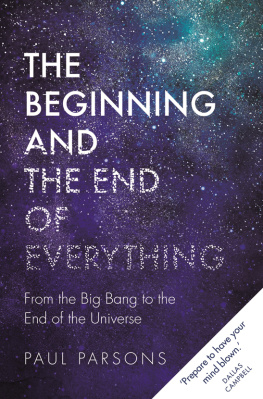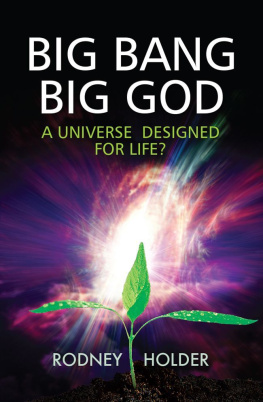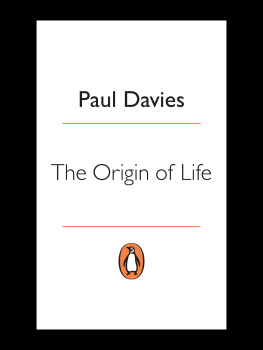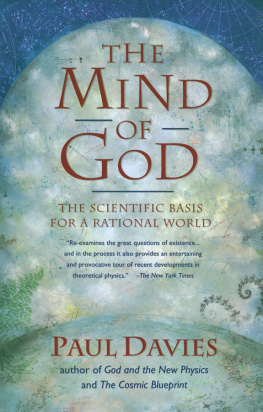
Table of Contents
First Mariner Books edition 2008
Copyright 2006 by Paul Davies
First published in Great Britain by The Penguin Press, a member of Penguin Group (UK), in 2006
ALL RIGHTS RESERVED
For information about permission to reproduce selections from this book, write to Permissions, Houghton Mifflin Harcourt Publishing Company, 215 Park Avenue South, New York, New York 10003.
www.hmhco.com
The Library of Congress has cataloged the print edition as follows:
Davies, P.C.W.
Cosmic jackpot : why our universe is just right
for life / Paul Davies.
p. cm.
Includes bibliographical references and index.
ISBN 978-0-618-59226-5
ISBN 978-0-547-05358-5 (pbk.)
1. Cosmogony. 2. Cosmology. 3. Teleology. 4. GodProof, Cosmological. 5. GodProof, Teleological. 6. Anthropic principle. 7. Human beings. 8. Life on other planets. I. Title.
BS 651. D 325 2007 523.1'2dc22 2006023567
e ISBN 978-0-547-34846-9
v2.1113
T O J OHN A RCHIBALD W HEELER
who was never afraid to tackle
the big questions
Preface and Acknowledgments
WHEN I WAS A PHD STUDENT at University College London in the 1960s, my supervisor handed me a curious technical paper to read as a bit of light relief from my major project. The paper (which was never actually published in the form in which I read it) was based on a lecture given in the United States by the young English cosmologist and theoretical physicist Brandon Carter. The subject matter was both radical and unusual. The normal work of a theoretical physicist is to investigate an unsolved problem about a natural phenomenon by applying the laws of physics in the form of mathematical equations and then trying to solve the equations to see how well they describe the real thing. But Carter was addressing an entirely different sort of problem, having to do with the forms of the laws themselves. He asked himself the following question: Suppose the laws had been a bit different from what they actually are, in this or that respectwhat would the consequences be? Philosophers call this type of investigation counterfactual analysis, and although fiction writers have long been fond of the device (I recently read a novel in which the Nazis defeated Britain in World War II and the UK became a German puppet state), it was groundbreaking for a scientist to consider.
The focus of Carters what if analysis was again unusual for a theoretical physicist. It concerned the existence of life. Specifically, Carters calculations suggested that if the laws had differed only slightly from what we find them to be, then life would not have been possible and the universe would have gone unobserved. In effect, said Carter, our existence hinges on a certain amount of delicate fine tuning of the laws. Like Goldilocks porridge, the laws of physics seemed to Carter to be just right for life. It looked like a fixa big fix. Somewhat unwisely, he named this fine-tuning the anthropic principle, giving the false impression that it concerned humankind specifically (which was never his intention).
It has formed the starting point for hundreds of papers over the years.
During the early 1980s, the anthropic principle was slammed by many scientists as quasi-religious mumbo jumbo. In a scathing put-down in the New York Review of Books in 1986, the mathematician and writer Martin Gardner itemized the various proposed versions of the anthropic principle (AP): Weak (WAP), Strong (SAP), Participatory (PAP), Final (FAP), andhis favored versionthe Completely Ridiculous Anthropic Principle (CRAP). It would of course be no surprise that we find ourselves living in a region fit for life, for we obviously could not be living in a place where life is impossible.
A follow-up workshop, with more emphasis on string theory (the currently fashionable attempt to unify physics), was held in March 2005.
While these theoretical developments were taking place, some spectacular advances were being made in observational cosmology. These came about from increasingly painstaking surveys of the universe by the Hubble Space Telescope and various ground-based instruments, the detailed mapping of the cosmic afterglow of the big bang by a satellite named WMAP, and the unexpected discovery that the universe is accelerating under the action of some mysterious dark energy. As a result of this fillip, cosmology, long a scientific backwater, suddenly became a mainstream science, with a ferment of new ideas, many of them weird and counterintuitive. It seems that we are now entering a new era that is transforming our view of the universe and the place of humankind within it.
In this book I shall explain the ideas that underlie these dramatic developments, focusing especially on the Goldilocks factorthe fitness of the universe for life. In the early chapters I shall set out the basic concepts of modern physics and cosmology and then describe the multiverse theory and the arguments for and against it. Toward the end of the book I shall take a critical look at the various responses to the fine-tuning issue. I shall also ask whether scientists really are on the verge of producing a theory of everythinga complete and self-contained explanation for the entire physical universeor whether there will always remain a mystery at the heart of existence.
For these later chapters I have drawn inspiration from the great theoretical physicist John Archibald Wheeler, to whom I have dedicated this book. I first learned of Wheelers work while I was a student, and in subsequent years I came to know him quite well, on both the personal and the professional level. I visited him in Austin, Texas, and he visited me in England on a number of occasions. He graciously endorsed my first book, The Physics of Time Asymmetry, with enthusiastic praise and took a keen interest in my work over three decades. It was a privilege to assist in the organization of his ninetieth-birthday party conference in March 2002, a gathering of extremely distinguished scientists in Princeton, New Jersey, where Wheeler began and ended his career.
In the late 1930s Wheeler worked with the legendary Niels Bohr on key aspects of nuclear fission. He went on to manage the rebirth of gravitational theory in the 1950s, taking up where Einstein left off. It was Wheeler who coined the terms black hole and wormhole. Above all, he recognized the need to reconcile the twin pillars of twentieth-century physicsthe general theory of relativity and quantum mechanicsin a unified theory of quantum gravity. Many of his graduate students have enjoyed scientific careers of immense distinction; one of them was the well-known Nobel Prize winner Richard Feynman.
Wheelers style was distinctive. He was the master of the thought experiment, taking an accepted idea and extrapolating it to the ultimate extreme, to see if and when it would break down. He loved to focus on the really big questions: whether physics could be unified; whether space and time could be derived from some more basic entity; whether causality could operate backward in time; whether the complex and abstract laws of physics could be reduced to a single, simple statement of the obvious; and how observers fitted into the scheme. Not content with simply applying the laws of quantum mechanics, he wanted to know where they came from: How come the quantum? he asked. Unhappy with the disjunction between the concepts of matter and information, he proposed the idea of it from bitthe emergence of particles from informational bits. Most ambitious of all was his question How come existence?an attempt to explain everything
Next page

